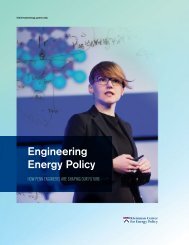2019-Annual-Report
You also want an ePaper? Increase the reach of your titles
YUMPU automatically turns print PDFs into web optimized ePapers that Google loves.
kleinmanenergy.upenn.edu 11
LACK OF PUBLIC INVOLVEMENT
Meanwhile, the City of Philadelphia, local communities, and other
interested stakeholders were not allowed adequate opportunity
to be informed or involved in remediation planning for the refinery.
This is inconsistent with the legal requirements of Pennsylvania’s
Act 2.
The omission of public involvement in the remediation planning
for the refinery is a meaningful grievance. Given the magnitude,
severity, and toxicity of the site’s contamination, coupled with its
proximity to highly populated environmental justice neighborhoods,
population centers, and drinking water resources, public
involvement is critical to informing the municipality and community
about existing risks, appropriateness of site-specific standards,
and remediation options.
At the time of this annual report’s publication, public comment
sessions are in full force—but organized by the city of Philadelphia;
not Sunoco. The Kleinman Center is actively participating in these
public comment sessions, gathering related Penn researchers to
advise on the best use of Philadelphia’s contaminated refinery site.
“This does raise some really
interesting questions that
people should ask. Do we
really understand the dangers
of industrial petrochemical
manufacturing in a highly
populated area?”
—CHRISTINA SIMEONE
FEATURED IN THE WALL STREET JOURNAL
Above: The PES refinery on fire. Located
just south of Philadelphia’s city center, the
refinery was producing 335,000 barrels
of crude oil a day and was Philadelphia’s
single biggest air polluter. It is now closed.
Photo courtesy of NBC News Philadelphia.




